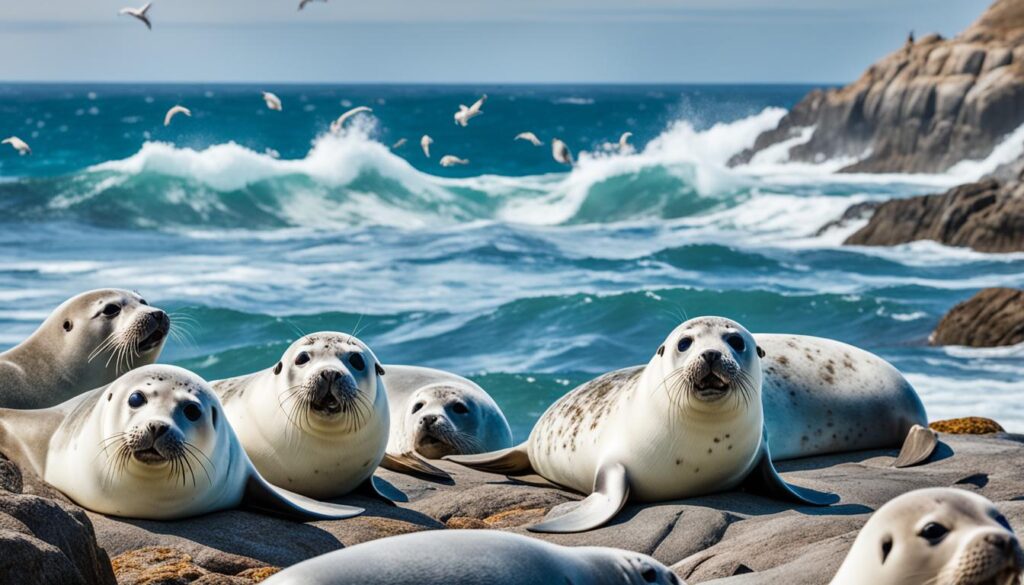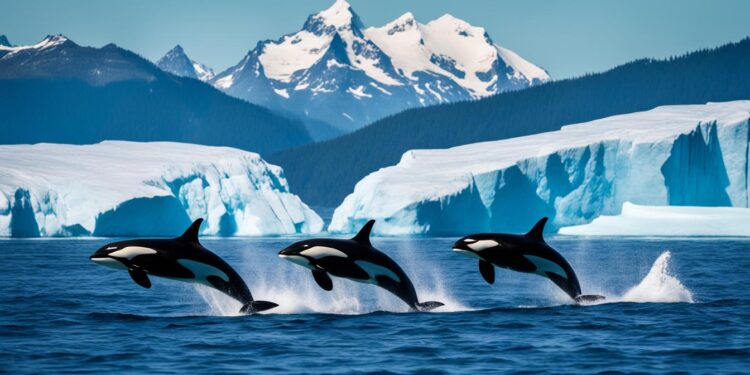Our oceans are filled with a variety of amazing creatures called marine mammals. These include everything from huge whales to beautiful seals. They are key to the health of our oceans.
These animals have special traits, live in complex groups, and hold deep cultural meanings. They are truly captivating and worth learning more about.
This article will take you on a journey into the world of marine mammals. We’ll look at their different types, where they live, and why they’re important. We’ll also talk about how we can help protect these incredible sea creatures.
Introduction to Marine Mammals
The ocean is filled with a wide variety of marine mammals, each one special in its own way. From the huge whales to the quick dolphins, and the fun seals to the strong polar bears, they all play key roles. These roles help keep the ocean’s balance just right.
Diverse Species and Habitats
Marine mammals include cetaceans like whales and dolphins, pinnipeds like seals and sea lions, and even polar bears. They have evolved to live in the ocean. They have bodies that are streamlined, fat to keep warm, and flippers or flukes for swimming. They live in many places, from the deep sea to coastal areas and even on Arctic ice.
Importance in Marine Ecosystems
Marine mammals are more than just fascinating to watch. They are crucial to the ocean’s health. As top predators, they keep the number of their prey in check. This helps keep the food web balanced.
Many marine mammals also act as indicators of the ocean’s health. They are sensitive to changes in their surroundings. By studying these animals, we can learn a lot about the state of our oceans.
Cetaceans: Whales and Dolphins
The world of cetaceans, home to whales and dolphins, shows how diverse and adaptable marine mammals can be. These smart and social creatures have always caught our attention. From the huge blue whale to the fun bottlenose dolphin, they amaze us.
Whales and dolphins are the biggest marine mammals. They have many physical and behavioral traits that help them live in the ocean. Their sleek bodies, strong tails, and sharp senses let them move deep, talk with others, and find food well.
Cetaceans are very smart and live in complex societies, often like humans. They talk in complex ways, form social groups, and show behaviors like working together, teaching, and playing. Studying how they communicate, eat, and move has given us a lot of insight into their lives.
From the big humpback whales that travel every year to the dolphins that do flips in the water, cetaceans are key to ocean life. They help keep the ocean’s balance. This shows why we must protect these amazing sea creatures.
Pinnipeds: Seals and Sea Lions
Pinnipeds, including seals and sea lions, are fascinating marine mammals. They have adapted well to life in the ocean. Their bodies and behaviors show how they can survive in the sea.
Unique Adaptations for Ocean Living
Seals and sea lions have bodies shaped for the water. Their streamlined forms and powerful flippers help them move through the ocean easily. They also have a thick layer of blubber to keep warm in cold water.

These creatures have special ways to find food in the ocean. Sea lions chase schools of fish with speed and agility. Harbor seals use their whiskers to find prey hidden in the depths.
Pinnipeds can live on both land and in the sea. Their skills show how well they’ve adapted to the ocean. They are successful predators, thanks to their unique traits.
Animal Intelligence and Communication
Marine mammals like whales, dolphins, and seals are very smart and have complex social lives. They show off their smarts with advanced thinking, complex ways of talking, and social behaviors. These skills are key to their survival and how they interact with each other.
Cetacean Intelligence and Communication
Cetaceans, which include whales and dolphins, are known for their high smarts and advanced communication. Whales, like humpbacks and orcas, use sounds like whistles and songs to share info about their social rank, who they want to mate with, and where they are in their group. Dolphins are famous for hunting together, having complex social ranks, and using echolocation to find their way around underwater.
Studies show that some marine mammals, like bottlenose dolphins, can see their own reflection in a mirror. This shows they have self-awareness and understand their own existence. This was once thought to be only for humans and a few other animals.
Social Behavior and Cooperation
Marine mammals are very social, often living in close groups and doing complex social things together. Seals and sea lions form big groups and work together to hunt and protect their babies. Killer whales, or orcas, hunt together, with each one having a special job in the group.
These marine mammals have social lives that are really complex, with deep friendships, empathy, and even acts of kindness. This shows how smart and communicative they are, which fascinates both researchers and the public.
Feeding and Migration Patterns
Marine mammals, from huge whales to quick dolphins and seals, have developed amazing ways to find and eat their food in the vast ocean. These creatures are not just top predators but also key players in keeping the ocean’s food webs balanced.
Species like humpback whales and killer whales have special hunting methods to catch their food, from tiny krill to big fish. They often hunt together, using their social skills to herd and trap their prey. Seals and sea lions, on the other hand, use their speed and diving skills to catch small fish, crustaceans, and mollusks in the deep ocean.
Marine mammals also have interesting migration patterns. These help them make the most of seasonal changes in the ocean. For example, humpback whales travel long distances between their summer feeding grounds in cold waters and their winter breeding grounds in warmer areas. These migrations are influenced by many factors, including water temperature, where their food is, and even the moon’s phases.
Learning about how marine mammals eat and migrate is not just interesting. It’s also vital for protecting them. By studying these behaviors, scientists can understand how healthy the ocean is and spot threats to these marine giants.
Conservation Efforts and Threats
Marine mammals like whales, dolphins, and seals have amazed us for centuries. But, they face many threats that could harm their survival. This section looks at the challenges they face and the work to protect them.
Climate Change and Habitat Loss
Climate change is a big threat to marine mammals. Rising temperatures and ocean changes harm their homes. Melting sea ice, rising sea levels, and changes in food are just a few issues.
Humans also harm marine mammals with overfishing, pollution, and bycatch. These actions destroy their homes, make finding food hard, and increase deaths. This puts these amazing animals at risk.
But, there are groups working to save marine mammals. Governments, environmental groups, and communities are setting up protected areas and reducing pollution. Their goal is to keep these animals safe for the future.

Dealing with climate change and other threats means we must focus on marine mammal conservation. By understanding their challenges and supporting their protection, we can keep their stories alive for future generations.
Marine Mammal Watching and Ecotourism
Seeing marine mammals in their natural setting has become a favorite activity for many. It lets people connect with these amazing creatures and learn about their role in nature. As more people seek out wildlife tours, watching marine mammals has become a key way to teach and protect them.
Marine mammal watching includes many activities, like whale-watching tours and visits to seal colonies. These activities let us see how these animals live and help local communities. They also support efforts to protect these important marine animals.
For marine mammal watching to be good for everyone, we must follow rules that protect the animals. This means keeping a safe distance, being quiet, and not touching or feeding them. By doing this, we can enjoy watching marine mammals without harming them or their homes.
As more people enjoy watching marine mammals, it’s a chance to teach the public about these creatures. It helps us appreciate them more and support their protection. By choosing responsible ecotourism, we can help protect marine mammals and their role in the ocean.
Cultural Significance and Folklore
Marine mammals have always been important in cultures around the world. They play a big role in myths, legends, and art. From whales to dolphins, these creatures have caught our attention for centuries. They inspire stories and myths that are rich and varied.
In many cultures, marine mammals are seen as spiritual beings. They are often thought to have special powers. The marine mammal cultural significance is shown in the art and carvings of coastal communities. These pieces show how closely tied these animals are to nature.
Mythology and Legends
The stories and myths about marine mammals are as varied as the animals themselves. There are tales of selkies from Celtic lore who could change from seals to humans. And there’s the story of the Japanese kappa, a water spirit that loved to ride dolphins.
In Inuit culture, the bowhead whale is seen as a wise and powerful creature. Its appearance is seen as a sign of big events or important news. The Māori of New Zealand think the orca, or “taniwha,” are spirits that protect and guide their people through the sea.
These stories show how important marine mammals are in our culture and folklore. They highlight the strong connection we have with these amazing creatures. This connection continues to inspire and fascinate people all over the world.
Future Research and Discoveries
Our understanding of marine mammals is growing, and new discoveries are coming. Scientists are exploring how these creatures communicate and live together. They’re using advanced tech like acoustic monitoring and drones to learn more about them.
Marine mammal research is on the brink of major breakthroughs that could change conservation. Researchers are studying how climate change and habitat loss affect these species. They aim to find new ways to protect them. By working together and combining different types of knowledge, we can make a big difference.
Studying marine mammals is not just interesting; it’s also vital for their survival. As we learn more about them, we can make better decisions to protect our oceans. These discoveries will help us understand and conserve marine mammals for the future.







